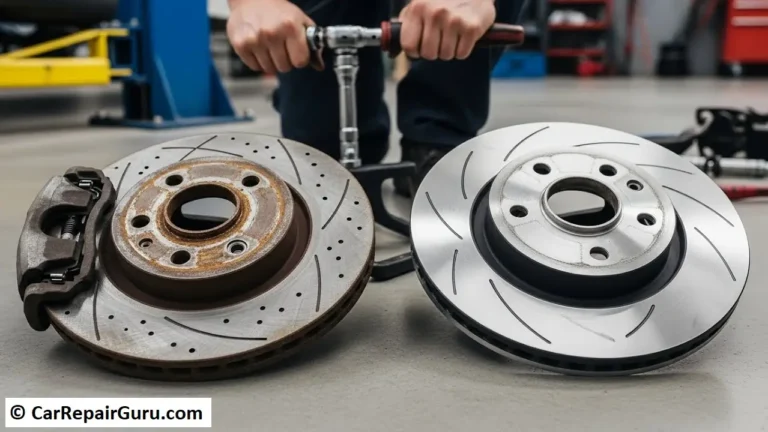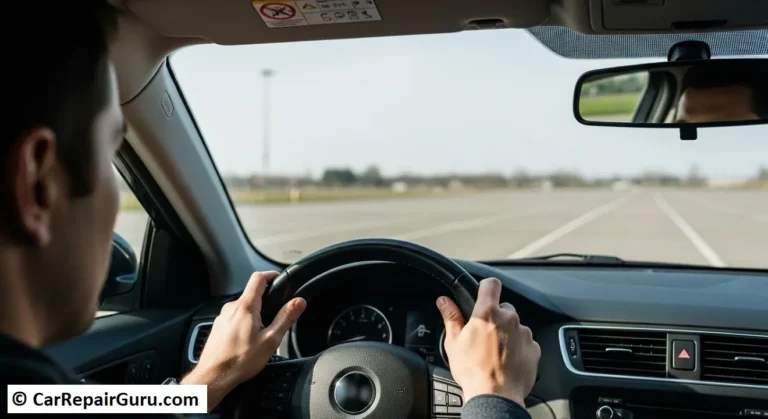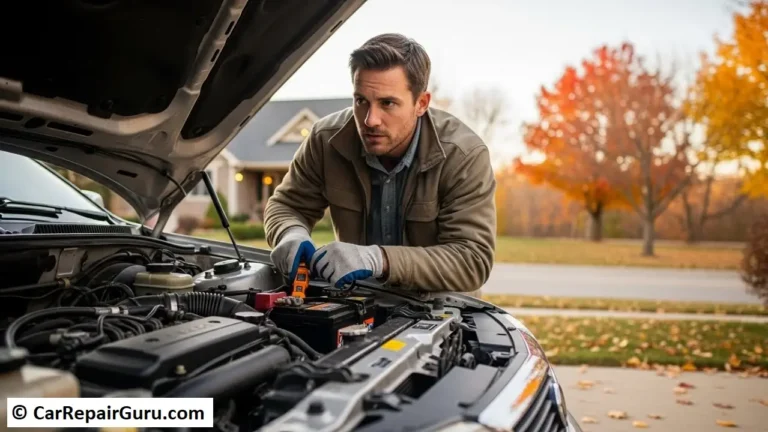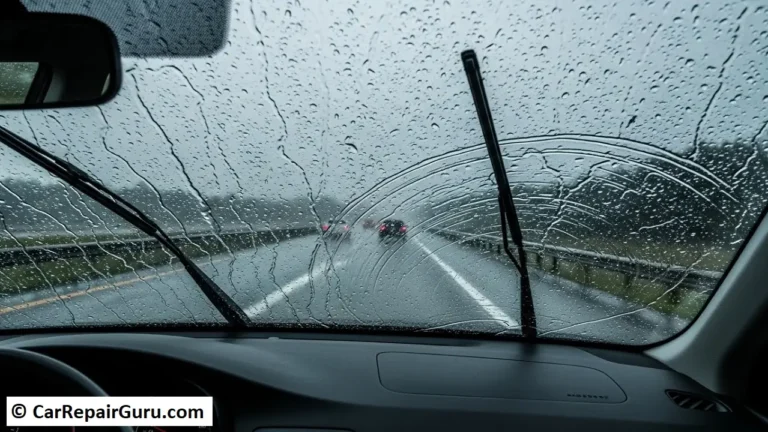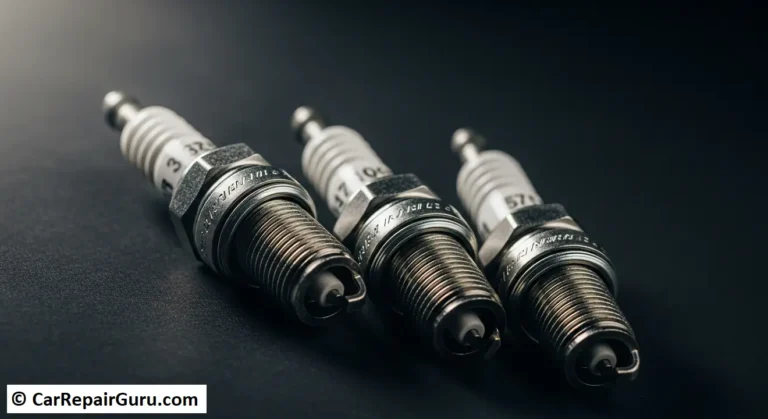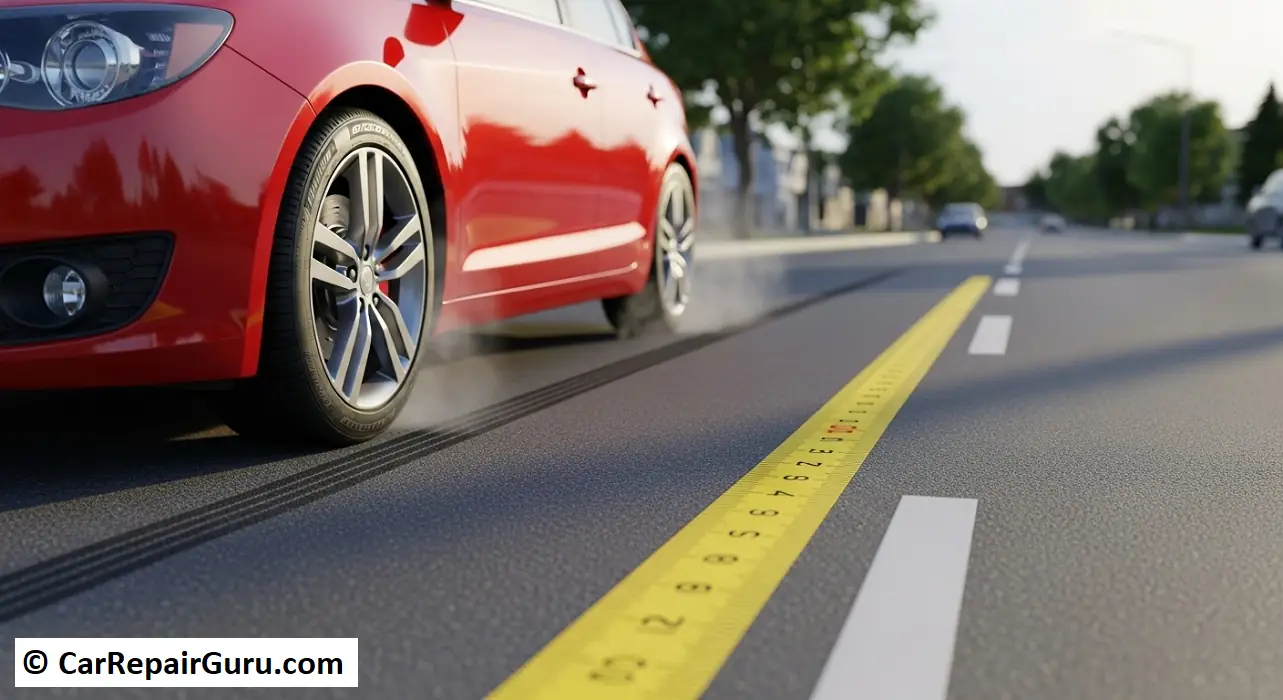
Have you ever slammed on the brakes and felt your heart race as your car came to a stop just in time? That moment—between spotting the danger and your car finally coming to a halt—is what stopping distance is all about.
Stopping distance refers to the total distance a vehicle travels from the moment the driver detects a hazard until the car comes to a complete stop. It’s not just about the brakes; it’s a combination of two critical elements: reaction time and braking distance. Together, they determine how long your vehicle needs to stop safely.
Understanding stopping distance isn’t just for passing a driving test—it’s a real-world safety essential. Whether you’re cruising on the highway or navigating city streets, knowing how quickly your car can stop can mean the difference between a close call and a collision.
In this guide, we’ll break down everything you need to know about stopping distance—from how it’s calculated to how you can reduce it. Let’s dive into the mechanics behind those crucial seconds that matter most on the road.
What Is Stopping Distance?
Stopping distance is the total length your vehicle travels from the moment you realize you need to stop to the moment your car actually comes to a complete halt. It’s not just about slamming the brakes—it’s a two-step process that involves how quickly you react and how effectively your vehicle can slow down.
Let’s break it down:
✅ Thinking Distance (Reaction Time)
This is the distance your car travels during the time it takes you to recognize a hazard and respond by hitting the brakes. It’s directly affected by your reaction time, which averages around 1.5 seconds for most drivers. But distractions, fatigue, or even alcohol can slow your reaction, increasing this distance dramatically.
✅ Braking Distance
Once you’ve hit the brakes, your car still needs time—and distance—to stop. That’s the braking distance. It depends on multiple factors such as your speed, road surface, tire condition, brake efficiency, and even the weather.
So, when we talk about stopping distance, we’re combining these two phases:
Stopping Distance = Thinking Distance + Braking Distance
It’s a simple formula, but the variables behind it make all the difference. At higher speeds or in poor conditions, both thinking and braking distances increase, which means your total stopping distance could double or even triple.
Understanding this equation is crucial—not just for safe driving, but for anticipating how your car behaves in emergency situations. When you know the limits of your stopping distance, you’re better equipped to make smart decisions on the road.
Factors That Affect Stopping Distance
Stopping distance isn’t fixed—it can vary a lot depending on a range of conditions. Whether you’re driving a compact car or a heavy SUV, several key factors come into play that can either shorten or significantly lengthen the distance it takes for your vehicle to stop.
Below are the main factors that affect stopping distance, broken down for clarity:
1. Vehicle Speed
- The faster you’re driving, the longer it takes to stop
- Stopping distance increases exponentially with speed—double your speed, and your braking distance can become up to four times longer
- Example: A car traveling at 50 km/h may stop in about 29 meters, while one going 100 km/h may need over 75 meters
2. Driver’s Reaction Time
- This is the time it takes for a driver to process a hazard and begin braking
- Slower reaction times increase the thinking distance
- Factors like fatigue, distractions, alcohol, or medication can slow reaction time
3. Road Conditions
- Wet, icy, or sandy roads reduce tire traction, increasing braking distance
- On dry pavement, tires grip better, resulting in shorter stopping distances
- On ice, braking distance can be up to 10 times longer than on dry roads
4. Tyre and Brake Condition
- Worn-out tires have less tread and can’t grip the road as well, especially in wet conditions
- Faulty or underperforming brakes will take longer to bring the vehicle to a stop
- Keeping both in top shape is key to reducing stopping distance
5. Vehicle Load and Type
- Heavier vehicles or those carrying loads require more braking force to stop
- Larger vehicles like trucks and vans have longer stopping distances than smaller cars
- Towing trailers or carrying heavy cargo also increases stopping distance
6. Weather Conditions
- Rain, fog, snow, or even strong winds can impact both reaction and braking ability
- Reduced visibility increases reaction time
- Slippery roads caused by rain or snow significantly increase braking distance
Key Takeaway: Even if your car has high-performance brakes and tires, external factors like speed and road conditions can dramatically affect how long it takes to stop. That’s why maintaining a safe distance and adapting to conditions is crucial for every driver.
Stopping Distance at Different Speeds
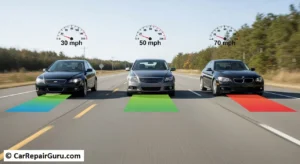
Speed plays one of the biggest roles in determining how long it takes your vehicle to come to a complete stop. As your speed increases, both thinking distance and braking distance increase—often more than you might expect.
To help you visualize the impact of speed on stopping distance, here’s a simple chart showing typical distances under dry road conditions for an average car with good brakes and tires:
Stopping Distance Table (Dry Road Conditions)
| Speed (km/h) | Thinking Distance (m) | Braking Distance (m) | Total Stopping Distance (m) |
|---|---|---|---|
| 30 | 9 | 6 | 15 |
| 50 | 15 | 14 | 29 |
| 70 | 21 | 24 | 45 |
| 100 | 30 | 45 | 75 |
Note: These values are approximate and assume dry conditions, a healthy vehicle, and a focused driver. Wet, icy, or uneven roads can increase braking distances significantly.
Why Speed Multiplies Risk
- At 30 km/h, your car stops in just 15 meters—roughly the length of a bus
- At 100 km/h, you need five times that distance—75 meters—which could be the length of a football field!
- This means a small increase in speed can lead to a much longer stopping distance—and more severe accidents if things go wrong
Real-Life Examples of Stopping Distances
It’s one thing to read numbers on a chart—but it’s another to feel the impact in real-life situations. Let’s look at a few everyday driving scenarios where stopping distance plays a critical role and how small changes in speed, road condition, or reaction time can lead to major consequences.
Example 1 – Sudden Pedestrian Crossing
You’re driving through a residential area at 50 km/h when a child suddenly runs into the street chasing a ball.
- Thinking Distance: At 50 km/h, your brain takes about 15 meters to process what’s happening and send a signal to your foot
- Braking Distance: Even with good brakes, your car will need another 14 meters to stop
- Total Stopping Distance: That’s nearly 30 meters—longer than most residential front yards
If you were distracted by your phone for even one second, your thinking distance alone could add several extra meters—enough to cause a serious accident.
Example 2 – Braking on Wet Roads
Now imagine you’re driving on the highway at 100 km/h in the rain. Suddenly, the car ahead brakes hard.
- On a dry road, your total stopping distance is around 75 meters
- On a wet road, your braking distance can double, making the total distance more than 100 meters
- If your tires are worn, or you brake too hard and skid, that distance grows even more
This is why it’s crucial to increase your following distance in bad weather, even if your car has ABS or other advanced braking systems.
Example 3 – City Traffic in Rush Hour
In heavy stop-and-go traffic, you’re driving at 30 km/h and following the car ahead too closely.
- You only need about 15 meters to stop safely
- But in traffic, many drivers follow with less than a one-car gap, leaving maybe 5–8 meters
- If the car ahead brakes suddenly, you won’t have enough time or space to react—leading to a rear-end collision
This scenario shows that even at low speeds, stopping distance matters—and most drivers underestimate it.
Takeaway: Understanding stopping distance in real-world conditions helps you make smarter decisions—maintain safe following distances, adjust speed to match road and weather conditions, and stay alert while minimizing distractions. Because when it comes to stopping in time, every meter counts.
How to Improve Stopping Distance
While you can’t control the weather or road conditions, there’s a lot you can do to improve your vehicle’s stopping distance and keep yourself—and others—safe on the road. Below are practical, proven tips every driver should follow.
1. Maintain a Safe Following Distance
- Follow the “3-second rule” in normal conditions—pick a fixed point on the road and count 3 seconds from when the car in front passes it. That’s your safe gap
- Increase the distance to 4–6 seconds in rain, fog, or at night
- A greater gap means more time to react and more room to stop safely
2. Keep Brakes and Tires in Top Condition
- Worn brake pads reduce braking efficiency and increase stopping distance
- Tire tread depth is critical—bald tires can’t grip the road, especially in wet conditions
- Regular inspections and timely maintenance ensure your car stops when you need it most
3. Avoid Distractions
- Even a 1-second distraction can add dozens of meters to your thinking distance
- Stay off your phone, limit in-car distractions, and stay mentally present
- Focused driving means quicker reaction times and better decision-making
4. Drive at Safe Speeds—Especially in Bad Weather
- Reduce speed when roads are wet, icy, or visibility is low
- Remember: doubling your speed can quadruple your braking distance
- Slower speeds buy you more time to react and more control during braking
5. Use ABS (Anti-lock Braking System) Effectively
- ABS prevents wheel lock-up, helping you maintain steering control during emergency stops
- In a panic stop, press the brake pedal firmly and don’t pump it—let ABS do the work
- Know how your car’s braking system behaves so you can respond with confidence
Bottom Line: Improving your stopping distance isn’t just about better equipment—it’s about better habits. Safe following distances, regular maintenance, alert driving, and speed control all add up to one thing: fewer accidents and safer roads.
Common Myths About Stopping Distance
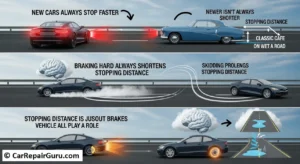
There’s a lot of misinformation out there about how stopping distance really works. These misconceptions can lead to overconfidence and dangerous driving habits. Let’s clear up some of the most common myths using real data and logic.
❌ Myth 1 – “New cars always stop faster”
Truth: While newer vehicles are often equipped with advanced braking systems like ABS and electronic brake-force distribution, they don’t guarantee shorter stopping distances in all conditions.
- A brand-new SUV may actually take longer to stop than an older, well-maintained compact car simply because of its weight and size
- What truly matters is the condition of the brakes, tires, and the road surface—not just the age of the vehicle
A new car with worn-out tires or overloaded cargo will still have a long stopping distance.
❌ Myth 2 – “Braking hard always shortens stopping distance”
Truth: Slamming on the brakes isn’t always the best or fastest way to stop—especially in slippery conditions.
- Without ABS, hard braking can cause wheels to lock up, leading to skidding and loss of control
- With ABS, the system pulses the brakes automatically to prevent skidding, but that doesn’t necessarily make the vehicle stop shorter—it helps you steer safely while braking
Controlled, steady braking is often more effective—especially in wet or icy conditions.
❌ Myth 3 – “Stopping distance is just about brakes”
Truth: Stopping distance is the sum of reaction time and braking distance. Even with perfect brakes, a slow or distracted reaction adds crucial meters to the total.
- At 100 km/h, just 1 extra second of delayed reaction adds nearly 28 meters to your stopping distance—more than six car lengths
- That’s why alertness and driver behavior are just as important as mechanical performance
Final Thought: Don’t fall for these myths. The reality is that safe driving habits, regular maintenance, and understanding your vehicle are what truly reduce stopping distance—not gimmicks, gadgets, or assumptions.
Stopping Distance vs Braking Distance
Many drivers mistakenly use the terms “stopping distance” and “braking distance” interchangeably—but they’re not the same. Understanding the difference can literally be the difference between a near-miss and a collision.
Quick Definitions
- Braking Distance: The distance your vehicle travels after you apply the brakes until it comes to a complete stop
- Stopping Distance: The total distance your vehicle travels from the moment you notice a hazard to the moment the car stops. Includes both thinking distance (reaction time) + braking distance
Side-by-Side Comparison
| Feature | Braking Distance | Stopping Distance |
|---|---|---|
| Starts from… | When you hit the brakes | When you first spot the hazard |
| Includes reaction time? | ❌ No | ✅ Yes |
| Influenced by… | Speed, road surface, brake/tire condition | All braking distance factors plus driver alertness |
| Example at 50 km/h | ~14 meters | ~29 meters |
Why Total Stopping Distance Matters Most
When you’re driving and suddenly need to stop, it’s not just how strong your brakes are that counts. It’s how quickly you realize there’s danger, how fast your foot gets to the pedal, and how efficiently your car slows down.
Even a small delay in your reaction—like checking your phone—adds meters to your stopping distance, not your braking distance, and that can be enough to cause an accident.
Key takeaway: Braking distance is just part of the equation. Total stopping distance is what keeps you and others safe—so always drive like it’s the full distance that counts.
Stopping Distance in Driving Tests and Theory Exams
If you’re preparing for a driving test—whether it’s your theory exam or practical assessment—you’ll definitely encounter questions about stopping distances. Understanding them isn’t just about passing the test—it’s also about being a safer driver on the road.
Why Stopping Distance Matters in Driving Exams
- In written theory tests, you’re often asked to recall typical stopping distances at different speeds
- In the practical test, examiners assess your ability to maintain safe following distances, adjust speed for conditions, and respond safely to hazards
Knowing how speed and environment affect your stopping distance shows examiners you’re ready for real-world driving.
Common Theory Exam Questions
Here are examples of typical questions:
- Q: What is the total stopping distance at 50 km/h in dry conditions?
- A: Around 29 meters
- Q: What factor affects both thinking and braking distance?
- A: Speed
- Q: Why is it important to keep a safe distance from the car ahead?
- A: To allow enough space to stop safely if the car brakes suddenly
These questions often come in multiple-choice or hazard perception formats, so understanding the concepts—not just memorizing numbers—is key.
Tips to Remember Stopping Distances
- Use the Speed x Interval Trick For dry conditions, stopping distance (in meters) is roughly: Speed (in mph or km/h) × 0.75 for thinking distance Speed² ÷ 20 for braking distance (km/h version)
- Use Mnemonics Create a memory aid for speeds and distances. For example: “Two-Nine-Four-Five-Seven-Five” → At 20 mph → 12m | 30 mph → 23m | 40 mph → 36m | etc.
- Group Speeds Together Learn them in pairs:
- 30 km/h ≈ 15 m
- 50 km/h ≈ 29 m
- 70 km/h ≈ 45 m
- 100 km/h ≈ 75 m
- Visual Memory Think of real-world equivalents:
- A car = ~4.5 meters
- A bus = ~12–14 meters
- A football field = ~100 meters
Quick Recap for Test Success
- Learn how stopping distances are calculated
- Understand how speed, weather, and driver attention impact them
- Practice sample questions regularly
- Remember: these distances are tested because they save lives in real driving situations
Conclusion
Understanding stopping distance is crucial for every driver. It’s not just about how quickly your car’s brakes work, but also how fast your brain reacts and the conditions around you. Here’s a quick recap of the key points:
- Stopping distance combines your reaction time (thinking distance) and the actual braking distance
- Factors like speed, road conditions, vehicle maintenance, and driver alertness all affect how quickly you can stop
- Real-life scenarios show just how important it is to maintain safe following distances and adjust your speed based on conditions
- Myths about stopping distance can mislead drivers, but knowing the facts helps you make smarter decisions on the road
The Bottom Line: Safe driving starts with awareness—being alert, avoiding distractions, and respecting your vehicle’s limits. Regularly checking your brakes and tires ensures your car is ready to stop when it matters most.
Remember: the difference between a close call and a crash often comes down to a few meters—and those meters depend on you.
Drive safe, stay alert, and give yourself plenty of stopping distance every time you hit the road.
FAQ
What is the formula for stopping distance?
The formula is: Stopping Distance = Thinking Distance (reaction time) + Braking Distance. It combines the distance your car travels while you react plus the distance it takes to stop once the brakes are applied.
How does speed affect stopping distance?
Speed has a huge impact. The faster you go, the longer both your thinking and braking distances become. In fact, braking distance increases with the square of the speed—so doubling your speed roughly quadruples your braking distance.
What’s the difference between braking distance and stopping distance?
Braking distance is the distance your vehicle covers after you apply the brakes. Stopping distance is the total distance traveled from the moment you spot a hazard until the car fully stops—it includes your reaction (thinking) distance plus braking distance.
How can weather conditions impact stopping distance?
Wet, icy, or slippery roads reduce tire grip, increasing braking distance significantly. Poor weather can also affect your reaction time due to reduced visibility or concentration, increasing thinking distance.
What is the safe stopping distance at 100 km/h?
On dry roads, the total stopping distance at 100 km/h is approximately 75 meters, combining about 28 meters of thinking distance and 47 meters of braking distance. This distance increases in poor weather or if your vehicle is not well maintained.
